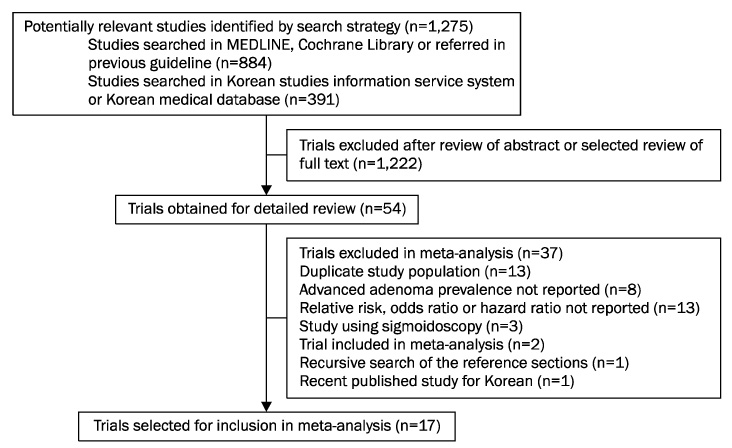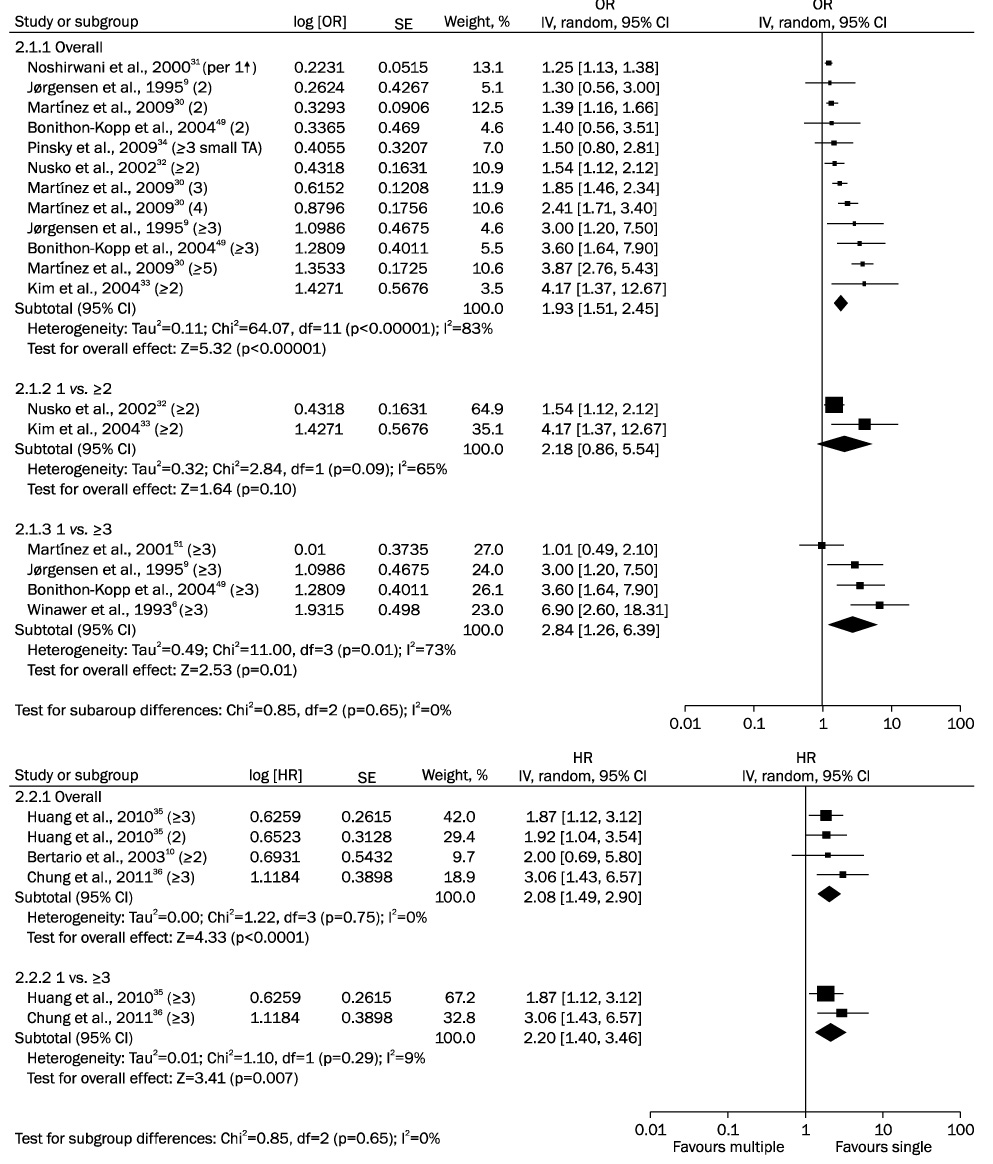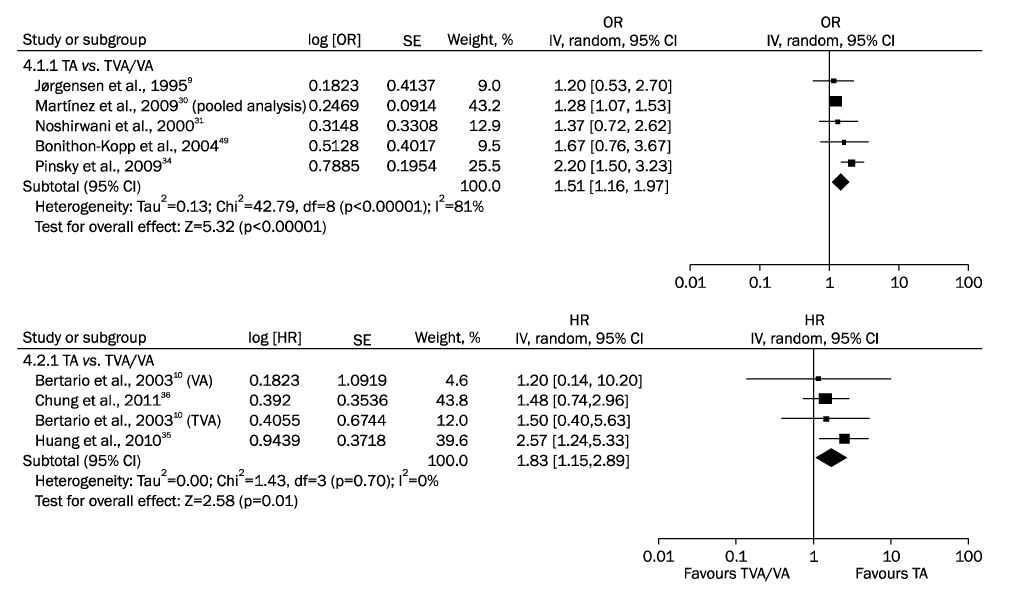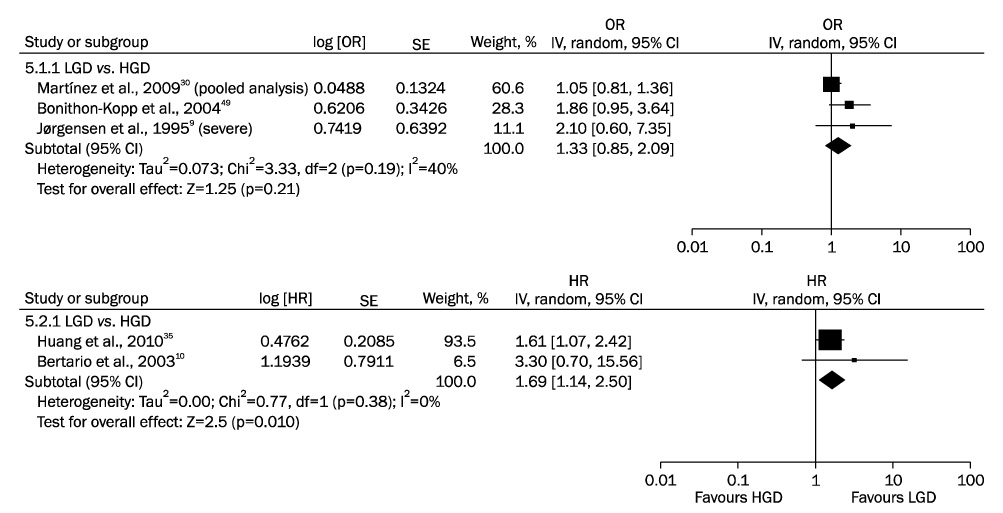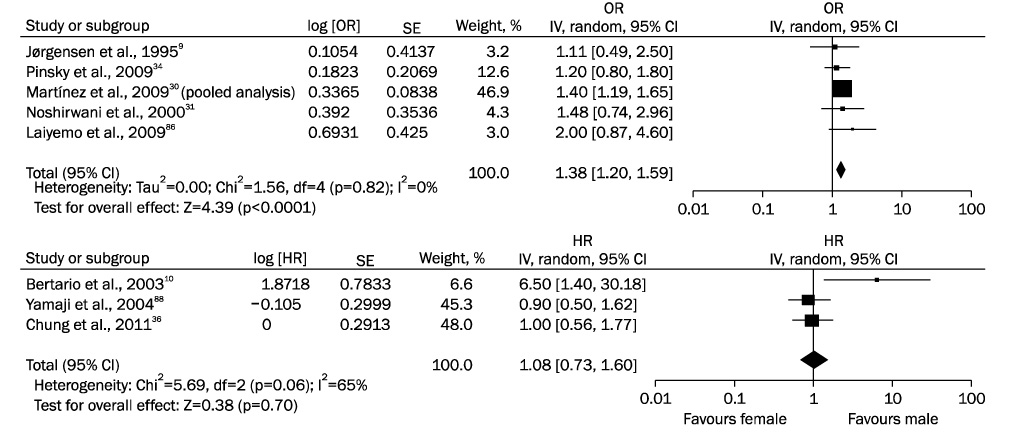Korean Guidelines for Post-polypectomy Colonoscopic Surveillance
- Affiliations
-
- 1Department of Internal Medicine, Konkuk University School of Medicine, Seoul, Korea.
- 2Department of Internal Medicine, University of Ulsan College of Medicine, Seoul, Korea.
- 3Department of Internal Medicine, Sungkyunkwan University School of Medicine, Seoul, Korea. younghokim@skku.edu
- 4Department of Internal Medicine, Yonsei University College of Medicine, Seoul, Korea.
- 5Department of Internal Medicine, Ajou University School of Medicine, Suwon, Korea.
- 6Department of Internal Medicine, Ewha Womans University School of Medicine, Seoul, Korea.
- 7Department of Internal Medicine, The Catholic University of Korea College of Medicine, Seoul, Korea.
- 8Department of Internal Medicine, Soonchunhyang University College of Medicine, Cheonan, Korea.
- 9Department of Internal Medicine, Yonsei University, Wonju College of Medicine, Wonju, Korea.
- 10Department of Internal Medicine, Kyunghee University College of Medicine, Seoul, Korea.
- 11Department of Radiology, Seoul National University College of Medicine, Seoul, Korea.
- 12Department of Preventive Medicine, Korea University College of Medicine, Seoul, Korea.
- KMID: 1792821
- DOI: http://doi.org/10.4166/kjg.2012.59.2.99
Abstract
- Post-polypectomy surveillance has become a major indication for colonoscopy as a result of increased use of screening colonoscopy in Korea. However, because the medical resource is limited, and the first screening colonoscopy produces the greatest effect on reducing the incidence and mortality of colorectal cancer, there is a need to increase the efficiency of postpolypectomy surveillance. In the present report, a careful analytic approach was used to address all available evidences to delineate the predictors for advanced neoplasia at surveillance colonoscopy. Based on the results of review of the evidences, we elucidated the high risk findings of the index colonoscopy as follows: 1) 3 or more adenomas, 2) any adenoma larger than 10 mm, 3) any tubulovillous or villous adenoma, 4) any adenoma with high-grade dysplasia, and 5) any serrated polyps larger than 10 mm. In patients without any high-risk findings at the index colonoscopy, surveillance colonoscopy should be performed five years after index colonoscopy. In patients with one or more high risk findings, surveillance colonoscopy should be performed three years after polypectomy. However, the surveillance interval can be shortened considering the quality of the index colonoscopy, the completeness of polyp removal, the patient's general condition, and family and medical history. This practical guideline cannot totally take the place of clinical judgments made by practitioners and should be revised and supplemented in the future as new evidence becomes available.
Keyword
MeSH Terms
Figure
Cited by 13 articles
-
Post-colonoscopy Colorectal Cancer: Causes and Prevention of Interval Colorectal Cancer
Jong Yoon Lee, Jong Hoon Lee
Korean J Gastroenterol. 2020;75(6):314-321. doi: 10.4166/kjg.2020.75.6.314.Risk Factors for Recurrent High-Risk Polyps after the Removal of High-Risk Polyps at Initial Colonoscopy
Hui Won Jang, Soo Jung Park, Sung Pil Hong, Jae Hee Cheon, Won Ho Kim, Tae Il Kim
Yonsei Med J. 2015;56(6):1559-1565. doi: 10.3349/ymj.2015.56.6.1559.Is It Useful to Perform Additional Colonoscopy to Detect Unmatched Lesion between Positron Emission Tomography/Computed Tomography and Colonoscopy?
Chang Yong Yun, Jun-Oh Jung, Seong O Suh, Ji Won Yoo, Yu Mi Oh, Soo Min Ahn, Hyoung Hun Sim, Eun Sil Kim, Ji Yoon Bae
Korean J Gastroenterol. 2013;61(6):319-326. doi: 10.4166/kjg.2013.61.6.319.Advanced Neoplasm Detection and Its Associated Factors in Colonoscopic Surveillance of Endoscopically Resected Early Colorectal Cancer
Soon Ha Kwon, Jin Woo Choo, Hyun Gun Kim, Seong Ran Jeon, Byung Hoo Lee, Tae Hee Lee, Wan Jung Kim, Bong Min Ko, Jin-Oh Kim, Joo Young Cho, Joon Seong Lee, Moon Sung Lee
Korean J Gastroenterol. 2013;62(4):219-226. doi: 10.4166/kjg.2013.62.4.219.Advanced Neoplasm Detection and Its Associated Factors in Colonoscopic Surveillance of Endoscopically Resected Early Colorectal Cancer
Soon Ha Kwon, Jin Woo Choo, Hyun Gun Kim, Seong Ran Jeon, Byung Hoo Lee, Tae Hee Lee, Wan Jung Kim, Bong Min Ko, Jin-Oh Kim, Joo Young Cho, Joon Seong Lee, Moon Sung Lee
Korean J Gastroenterol. 2013;62(4):219-226. doi: 10.4166/kjg.2013.62.4.219.Immunohistochemical Expression of p53, Bcl-2, and Ki-67 Proteins in Traditional Serrated Adenomas of Colon
Jin Hwan Jung, Heon-Ju Kwon, Tae-Jung Kim, Hyung Jun Cho, Hye Kang Kim, Dae Young Cheung, Jin Il Kim, Jae Kwang Kim
Korean J Gastroenterol. 2013;62(6):336-343. doi: 10.4166/kjg.2013.62.6.336.Rapidly Growing Interval Colon Cancer
Jae Hyun Kim, Moo In Park
Korean J Gastroenterol. 2015;65(5):326-329. doi: 10.4166/kjg.2015.65.5.326.Why Do Clinicians Recommend Shorter Interval Surveillance in Patients with Low-risk Colorectal Adenomas?
Jae Jun Park
Korean J Gastroenterol. 2017;69(6):382-384. doi: 10.4166/kjg.2017.69.6.382.Prevalence and Risk Factors of Colorectal Adenoma in 14,932 Koreans Undergoing Screening Colonoscopy
Hee Sun Kim, Su Jung Baik, Kyung Hee Kim, Cho Rong Oh, Sang In Lee
Korean J Gastroenterol. 2013;62(2):104-110. doi: 10.4166/kjg.2013.62.2.104.Long-term Risk of Colorectal Cancer Development According to Adenoma Detection Rate
Jung Won Lee
Korean J Gastroenterol. 2021;78(4):252-254. doi: 10.4166/kjg.2021.122.Optimal Colonoscopy Surveillance Interval after Polypectomy
Tae Oh Kim
Clin Endosc. 2016;49(4):359-363. doi: 10.5946/ce.2016.080.Korean guidelines for postpolypectomy colonoscopic surveillance: 2022 revised edition
Su Young Kim, Min Seob Kwak, Soon Man Yoon, Yunho Jung, Jong Wook Kim, Sun-Jin Boo, Eun Hye Oh, Seong Ran Jeon, Seung-Joo Nam, Seon-Young Park, Soo-Kyung Park, Jaeyoung Chun, Dong Hoon Baek, Mi-Young Choi, Suyeon Park, Jeong-Sik Byeon, Hyung Kil Kim, Joo Young Cho, Moon Sung Lee, Oh Young Lee
Clin Endosc. 2022;55(6):703-725. doi: 10.5946/ce.2022.136.Korean Guidelines for Postpolypectomy Colonoscopic Surveillance: 2022 revised edition
Su Young Kim, Min Seob Kwak, Soon Man Yoon, Yunho Jung, Jong Wook Kim, Sun-Jin Boo, Eun Hye Oh, Seong Ran Jeon, Seung-Joo Nam, Seon-Young Park, Soo-Kyung Park, Jaeyoung Chun, Dong Hoon Baek, Mi-Young Choi, Suyeon Park, Jeong-Sik Byeon, Hyung Kil Kim, Joo Young Cho, Moon Sung Lee, Oh Young Lee
Intest Res. 2023;21(1):20-42. doi: 10.5217/ir.2022.00096.
Reference
-
1. Thiis-Evensen E, Hoff GS, Sauar J, Langmark F, Majak BM, Vatn MH. Population-based surveillance by colonoscopy: effect on the incidence of colorectal cancer. Telemark Polyp Study I. Scand J Gastroenterol. 1999. 34:414–420.2. Citarda F, Tomaselli G, Capocaccia R, Barcherini S, Crespi M. Italian Multicentre Study Group. Efficacy in standard clinical practice of colonoscopic polypectomy in reducing colorectal cancer incidence. Gut. 2001. 48:812–815.3. Loeve F, van Ballegooijen M, Snel P, Habbema JD. Colorectal cancer risk after colonoscopic polypectomy: a population-based study and literature search. Eur J Cancer. 2005. 41:416–422.4. Stryker SJ, Wolff BG, Culp CE, Libbe SD, Ilstrup DM, MacCarty RL. Natural history of untreated colonic polyps. Gastroenterology. 1987. 93:1009–1013.5. Winawer SJ, Zauber AG, Ho MN, et al. The National Polyp Study Workgroup. Prevention of colorectal cancer by colonoscopic polypectomy. N Engl J Med. 1993. 329:1977–1981.6. Winawer SJ, Zauber AG, O'Brien MJ, et al. Randomized comparison of surveillance intervals after colonoscopic removal of newly diagnosed adenomatous polyps. The National Polyp Study Workgroup. N Engl J Med. 1993. 328:901–906.7. Meagher AP, Stuart M. Does colonoscopic polypectomy reduce the incidence of colorectal carcinoma? Aust N Z J Surg. 1994. 64:400–404.8. Lund JN, Scholefield JH, Grainge MJ, et al. Risks, costs, and compliance limit colorectal adenoma surveillance: lessons from a randomised trial. Gut. 2001. 49:91–96.9. Jørgensen OD, Kronborg O, Fenger C. A randomized surveillance study of patients with pedunculated and small sessile tubular and tubulovillous adenomas. The Funen Adenoma Follow-up Study. Scand J Gastroenterol. 1995. 30:686–692.10. Bertario L, Russo A, Sala P, et al. Predictors of metachronous colorectal neoplasms in sporadic adenoma patients. Int J Cancer. 2003. 105:82–87.11. Atkin WS, Morson BC, Cuzick J. Long-term risk of colorectal cancer after excision of rectosigmoid adenomas. N Engl J Med. 1992. 326:658–662.12. National Health Insurance Statistical Yearbook for 2009. The National Health Insurance Corporation. 2010. http://www.nhic.or.kr/portal/site/main/menuitem.e0e5d150f021cfe46e20bbb5b210101c.13. Trend of studies about economic evaluation of the cancer screening programs. Health Insurance Policy Research Institute, The National Health Insurance Corporation. 2009. http://www.nhic.or.kr/portal/site/main/menuitem.42a779d76d7f8c38b31148b4062310a0/.14. Rapuri S, Spencer J, Eckels D. Importance of postpolypectomy surveillance and postpolypectomy compliance to follow-up screening--review of literature. Int J Colorectal Dis. 2008. 23:453–459.15. Arditi C, Peytremann-Bridevaux I, Burnand B, et al. EPAGE II Study Group. Appropriateness of colonoscopy in Europe (EPAGE II). Screening for colorectal cancer. Endoscopy. 2009. 41:200–208.16. Bond JH. Polyp guideline: diagnosis, treatment, and surveillance for patients with colorectal polyps. Practice Parameters Committee of the American College of Gastroenterology. Am J Gastroenterol. 2000. 95:3053–3063.17. Cairns SR, Scholefield JH, Steele RJ, et al. British Society of Gastroenterology. Association of Coloproctology for Great Britain and Ireland. Guidelines for colorectal cancer screening and surveillance in moderate and high risk groups (update from 2002). Gut. 2010. 59:666–689.18. Davila RE, Rajan E, Baron TH, et al. Standards of Practice Committee, American Society for Gastrointestinal Endoscopy. ASGE guideline: colorectal cancer screening and surveillance. Gastrointest Endosc. 2006. 63:546–557.19. Levin B, Lieberman DA, McFarland B, et al. American Cancer Society Colorectal Cancer Advisory Group. US Multi-Society Task Force. American College of Radiology Colon Cancer Committee. Screening and surveillance for the early detection of colorectal cancer and adenomatous polyps, 2008: a joint guideline from the American Cancer Society, the US Multi-Society Task Force on Colorectal Cancer, and the American College of Radiology. Gastroenterology. 2008. 134:1570–1595.20. Schmiegel W, Pox C, Arnold D, Porschen R, Rödel C, Reinacher-Schick A. Association of the Scientific Medical Societies in Germany. German Cancer Aid. German Cancer Society. German Society for Digestive and Metabolic Diseases. German Society for General and Visceral Surgery. German Society for Hematology and Oncology. German Society for Pathology. German Society for Radiooncology. German Roentgen Society. German Joint Society for Clinical Chemistry and Laboratory Medicine. German Society for Coloproctology. Association of Stoma Patients and Persons with Intestinal Cancer. German Crohn's Disease and Ulcerative Colitis Association. German Society for Internal Medicine. Colorectal carcinoma: the management of polyps, (neo)adjuvant therapy, and the treatment of metastases. Dtsch Arztebl Int. 2009. 106:843–848.21. Winawer SJ, Zauber AG, Fletcher RH, et al. US Multi-Society Task Force on Colorectal Cancer. American Cancer Society. Guidelines for colonoscopy surveillance after polypectomy: a consensus update by the US Multi-Society Task Force on Colorectal Cancer and the American Cancer Society. Gastroenterology. 2006. 130:1872–1885.22. Jung KW, Park S, Kong HJ, et al. Cancer statistics in Korea: incidence, mortality and survival in 2006-2007. J Korean Med Sci. 2010. 25:1113–1121.23. Park DI, Kim YH, Kim HS, et al. Diagnostic yield of advanced colorectal neoplasia at colonoscopy, according to indications: an investigation from the Korean Association for the Study of Intestinal Diseases (KASID). Endoscopy. 2006. 38:449–455.24. Lee BH, Jeong SY. Korean national recommendation guidelines on screening and surveillance for early detection of colorectal cancers. J Korean Med Assoc. 2002. 45:981–991.25. Population Projections for Korea: 2005-2050 (Based on the 2005 Census). Korea National Statistical Office. 2006. http://kosis.kr/gen_etl/start.jsp?orgId=101&tblId=DT_1B01001&conn_path=I2&path=인구·가구 - 추계인구·가구 - 장래인구추계 - 연령별(전국) 추계인구.26. The quality guidelines of colorectal cancer screening. Ministry for Health, Walfare and Family Affairs. 2008. http://www.cancer.go.kr/cms/data/edudata/__icsFiles/afieldfile/2009/07/20/bb.mht.27. Zhang J, Yu KF. What's the relative risk? A method of correcting the odds ratio in cohort studies of common outcomes. JAMA. 1998. 280:1690–1691.28. Guyatt GH, Oxman AD, Vist GE, et al. GRADE Working Group. GRADE: an emerging consensus on rating quality of evidence and strength of recommendations. BMJ. 2008. 336:924–926.29. Atkins D, Best D, Briss PA, et al. GRADE Working Group. Grading quality of evidence and strength of recommendations. BMJ. 2004. 328:1490.30. Martínez ME, Baron JA, Lieberman DA, et al. A pooled analysis of advanced colorectal neoplasia diagnoses after colonoscopic polypectomy. Gastroenterology. 2009. 136:832–841.31. Noshirwani KC, van Stolk RU, Rybicki LA, Beck GJ. Adenoma size and number are predictive of adenoma recurrence: implications for surveillance colonoscopy. Gastrointest Endosc. 2000. 51:433–437.32. Nusko G, Mansmann U, Kirchner T, Hahn EG. Risk related surveillance following colorectal polypectomy. Gut. 2002. 51:424–428.33. Kim JB, Han DS, Lee HL, et al. The recurrence rate of colon polyp after polypectomy and the interval of surveillance colonoscopy: predictors of early development of advanced polyp. Korean J Gastroenterol. 2004. 44:77–83.34. Pinsky PF, Schoen RE, Weissfeld JL, et al. The yield of surveillance colonoscopy by adenoma history and time to examination. Clin Gastroenterol Hepatol. 2009. 7:86–92.35. Huang Y, Gong W, Su B, et al. Recurrence and surveillance of colorectal adenoma after polypectomy in a southern Chinese population. J Gastroenterol. 2010. 45:838–845.36. Chung SJ, Kim YS, Yang SY, et al. Five-year risk for advanced colorectal neoplasia after initial colonoscopy according to the baseline risk stratification: a prospective study in 2452 asymptomatic Koreans. Gut. 2011. 60:1537–1543.37. Saini SD, Kim HM, Schoenfeld P. Incidence of advanced adenomas at surveillance colonoscopy in patients with a personal history of colon adenomas: a meta-analysis and systematic review. Gastrointest Endosc. 2006. 64:614–626.38. Chung CS, Yoon JS, Joh YG, et al. Colonoscopic missing rate of colorectal polyps. Korean J Gastrointest Endosc. 2004. 28:179–182.39. Choi KY, Lee BI, Lee SY, et al. Colonoscopic miss-rate of colorectal polyp and adenoma. Korean J Gastrointest Endosc. 2003. 26:199–204.40. Park SY, Moon W, Park SJ, et al. The colonoscopic miss rates of colorectal polyps as determined by a polypectomy. Korean J Gastrointest Endosc. 2008. 36:132–137.41. Kim JH, Kim YS, Cheon JH, et al. Influence of the insertion time and number of polyps on miss rate in colonoscopy. Scand J Gastroenterol. 2011. 46:634–639.42. Heresbach D, Barrioz T, Lapalus MG, et al. Miss rate for colorectal neoplastic polyps: a prospective multicenter study of back-to-back video colonoscopies. Endoscopy. 2008. 40:284–290.43. Hixson LJ, Fennerty MB, Sampliner RE, Garewal HS. Prospective blinded trial of the colonoscopic miss-rate of large colorectal polyps. Gastrointest Endosc. 1991. 37:125–127.44. Ben-Horin S, Bar-Meir S, Avidan B. The impact of colon cleanliness assessment on endoscopists' recommendations for follow-up colonoscopy. Am J Gastroenterol. 2007. 102:2680–2685.45. Kang MS, Park DI, Park JH, et al. A survey on the interval of post-polypectomy surveillance colonoscopy. Korean J Gastrointest Endosc. 2006. 33:339–345.46. Hisabe T, Tsuda S, Matsui T, Iwashita A. Natural history of small colorectal protuberant adenomas. Dig Endosc. 2010. 22:Suppl 1. S43–S46.47. Hoff G, Foerster A, Vatn MH, Sauar J, Larsen S. Epidemiology of polyps in the rectum and colon. Recovery and evaluation of unresected polyps 2 years after detection. Scand J Gastroenterol. 1986. 21:853–862.48. Hofstad B, Vatn MH, Andersen SN, et al. Growth of colorectal polyps: redetection and evaluation of unresected polyps for a period of three years. Gut. 1996. 39:449–456.49. Bonithon-Kopp C, Piard F, Fenger C, et al. European Cancer Prevention Organisation Study Group. Colorectal adenoma characteristics as predictors of recurrence. Dis Colon Rectum. 2004. 47:323–333.50. van Stolk RU, Beck GJ, Baron JA, Haile R, Summers R. The Polyp Prevention Study Group. Adenoma characteristics at first colonoscopy as predictors of adenoma recurrence and characteristics at follow-up. Gastroenterology. 1998. 115:13–18.51. Martínez ME, Sampliner R, Marshall JR, Bhattacharyya AK, Reid ME, Alberts DS. Adenoma characteristics as risk factors for recurrence of advanced adenomas. Gastroenterology. 2001. 120:1077–1083.52. Lieberman DA, Weiss DG, Harford WV, et al. Five-year colon surveillance after screening colonoscopy. Gastroenterology. 2007. 133:1077–1085.53. Laiyemo AO, Murphy G, Albert PS, et al. Postpolypectomy colonoscopy surveillance guidelines: predictive accuracy for advanced adenoma at 4 years. Ann Intern Med. 2008. 148:419–426.54. Nivatvongs S, Snover DC, Fang DT. Piecemeal snare excision of large sessile colon and rectal polyps: is it adequate? Gastrointest Endosc. 1984. 30:18–20.55. Seo GJ, Sohn DK, Han KS, et al. Recurrence after endoscopic piecemeal mucosal resection for large sessile colorectal polyps. World J Gastroenterol. 2010. 16:2806–2811.56. Saito Y, Fukuzawa M, Matsuda T, et al. Clinical outcome of endoscopic submucosal dissection versus endoscopic mucosal resection of large colorectal tumors as determined by curative resection. Surg Endosc. 2010. 24:343–352.57. Seitz U, Bohnacker S, Seewald S, Thonke F, Soehendra N. Long-term results of endoscopic removal of large colorectal adenomas. Endoscopy. 2003. 35:S41–S44.58. Walsh RM, Ackroyd FW, Shellito PC. Endoscopic resection of large sessile colorectal polyps. Gastrointest Endosc. 1992. 38:303–309.59. Zlatanic J, Waye JD, Kim PS, Baiocco PJ, Gleim GW. Large sessile colonic adenomas: use of argon plasma coagulator to supplement piecemeal snare polypectomy. Gastrointest Endosc. 1999. 49:731–735.60. Brooker JC, Saunders BP, Shah SG, Williams CB. Endoscopic resection of large sessile colonic polyps by specialist and non-specialist endoscopists. Br J Surg. 2002. 89:1020–1024.61. Conio M, Repici A, Demarquay JF, Blanchi S, Dumas R, Filiberti R. EMR of large sessile colorectal polyps. Gastrointest Endosc. 2004. 60:234–241.62. Hwang ST, Cho YK, Park JH, et al. Relationship of non-alcoholic fatty liver disease to colorectal adenomatous polyps. J Gastroenterol Hepatol. 2010. 25:562–567.63. Yang G, Zheng W, Sun QR, et al. Pathologic features of initial adenomas as predictors for metachronous adenomas of the rectum. J Natl Cancer Inst. 1998. 90:1661–1665.64. Terdiman JP, McQuaid KR. Surveillance guidelines should be updated to recognize the importance of serrated polyps. Gastroenterology. 2010. 139:1444–1447.65. Leggett B, Whitehall V. Role of the serrated pathway in colorectal cancer pathogenesis. Gastroenterology. 2010. 138:2088–2100.66. Arain MA, Sawhney M, Sheikh S, et al. CIMP status of interval colon cancers: another piece to the puzzle. Am J Gastroenterol. 2010. 105:1189–1195.67. Sawhney MS, Farrar WD, Gudiseva S, et al. Microsatellite instability in interval colon cancers. Gastroenterology. 2006. 131:1700–1705.68. Hiraoka S, Kato J, Fujiki S, et al. The presence of large serrated polyps increases risk for colorectal cancer. Gastroenterology. 2010. 139:1503–1510. 1510.e1–1510.e3.69. Schreiner MA, Weiss DG, Lieberman DA. Proximal and large hyperplastic and nondysplastic serrated polyps detected by colonoscopy are associated with neoplasia. Gastroenterology. 2010. 139:1497–1502.70. Li D, Jin C, McCulloch C, et al. Association of large serrated polyps with synchronous advanced colorectal neoplasia. Am J Gastroenterol. 2009. 104:695–702.71. Bensen SP, Cole BF, Mott LA, Baron JA, Sandler RS, Haile R. Colorectal hyperplastic polyps and risk of recurrence of adenomas and hyperplastic polyps. Polyps Prevention Study. Lancet. 1999. 354:1873–1874.72. Lu FI, van Niekerk de W, Owen D, Tha SP, Turbin DA, Webber DL. Longitudinal outcome study of sessile serrated adenomas of the colorectum: an increased risk for subsequent right-sided colorectal carcinoma. Am J Surg Pathol. 2010. 34:927–934.73. Lim HM, Kim ER, Kim JY, et al. Association between non-diminutive hyperplastic polyps and synchronous advanced colorectal neoplasms. Digestion. 2011. 83:54–59.74. Laiyemo AO, Doubeni C, Sanderson AK 2nd, et al. Likelihood of missed and recurrent adenomas in the proximal versus the distal colon. Gastrointest Endosc. 2011. 74:253–261.75. Iacopetta B. Are there two sides to colorectal cancer? Int J Cancer. 2002. 101:403–408.76. Urso E, Pucciarelli S, Agostini M, et al. Proximal colon cancer in patients aged 51-60 years of age should be tested for microsatellites instability. A comment on the Revised Bethesda Guidelines. Int J Colorectal Dis. 2008. 23:801–806.77. Baxter NN, Goldwasser MA, Paszat LF, Saskin R, Urbach DR, Rabeneck L. Association of colonoscopy and death from colorectal cancer. Ann Intern Med. 2009. 150:1–8.78. Brenner H, Chang-Claude J, Seiler CM, Rickert A, Hoffmeister M. Protection from colorectal cancer after colonoscopy: a population-based, case-control study. Ann Intern Med. 2011. 154:22–30.79. Yoshida D, Kono S, Moore MA, et al. Colorectal polypectomy and risk of colorectal cancer by subsite: the Fukuoka Colorectal Cancer study. Jpn J Clin Oncol. 2007. 37:597–602.80. Kim YG, Jang BI, Kim TN. A matched case-control study of a novel Acid-pump antagonist and proton-pump inhibitor for the treatment of iatrogenic ulcers caused by endoscopic submucosal dissection. Gut Liver. 2010. 4:25–30.81. Yamaji Y, Mitsushima T, Ikuma H, et al. Right-side shift of colorectal adenomas with aging. Gastrointest Endosc. 2006. 63:453–458.82. Schoenfeld P, Cash B, Flood A, et al. CONCeRN Study Investigators. Colonoscopic screening of average-risk women for colorectal neoplasia. N Engl J Med. 2005. 352:2061–2068.83. Ferretti G, Felici A, Cognetti F, Mandala M. Is there a right-sided shift for colorectal cancer in women compared with men? Cancer Epidemiol Biomarkers Prev. 2006. 15:1054.84. Rabeneck L, Davila JA, El-Serag HB. Is there a true "shift" to the right colon in the incidence of colorectal cancer? Am J Gastroenterol. 2003. 98:1400–1409.85. Park SY, Kim BC, Shin SJ, Lee SK, Kim TI, Kim WH. Proximal shift in the distribution of adenomatous polyps in Korea over the past ten years. Hepatogastroenterology. 2009. 56:677–681.86. Laiyemo AO, Pinsky PF, Marcus PM, et al. Utilization and yield of surveillance colonoscopy in the continued follow-up study of the polyp prevention trial. Clin Gastroenterol Hepatol. 2009. 7:562–567.87. Robertson DJ, Burke CA, Welch HG, et al. Using the results of a baseline and a surveillance colonoscopy to predict recurrent adenomas with high-risk characteristics. Ann Intern Med. 2009. 151:103–109.88. Yamaji Y, Mitsushima T, Ikuma H, et al. Incidence and recurrence rates of colorectal adenomas estimated by annually repeated colonoscopies on asymptomatic Japanese. Gut. 2004. 53:568–572.89. Lebwohl B, Kastrinos F, Glick M, Rosenbaum AJ, Wang T, Neugut AI. The impact of suboptimal bowel preparation on adenoma miss rates and the factors associated with early repeat colonoscopy. Gastrointest Endosc. 2011. 73:1207–1214.90. Barclay RL, Vicari JJ, Doughty AS, Johanson JF, Greenlaw RL. Colonoscopic withdrawal times and adenoma detection during screening colonoscopy. N Engl J Med. 2006. 355:2533–2541.91. Chen SC, Rex DK. Endoscopist can be more powerful than age and male gender in predicting adenoma detection at colonoscopy. Am J Gastroenterol. 2007. 102:856–861.92. Baxter NN, Sutradhar R, Forbes SS, Paszat LF, Saskin R, Rabeneck L. Analysis of administrative data finds endoscopist quality measures associated with postcolonoscopy colorectal cancer. Gastroenterology. 2011. 140:65–72.
- Full Text Links
- Actions
-
Cited
- CITED
-
- Close
- Share
- Similar articles
-
- Summary and comparison of recently updated post-polypectomy surveillance guidelines
- Strategy for post-polypectomy colonoscopy surveillance: focus on the revised Korean guidelines
- Post-polypectomy surveillance: the present and the future
- Korean Guidelines for Postpolypectomy Colonoscopic Surveillance: 2022 Revision
- A Survey of Colonoscopic Surveillance After Polypectomy

